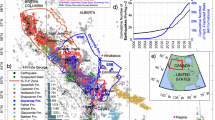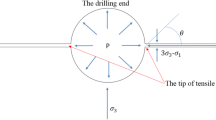Abstract
Earthquakes can be triggered by any significant perturbation of the hydrologic regime. In areas where potentially active faults are already close to failure, the increased pore pressure resulting from fluid injection, or, alternatively, the massive extraction of fluid or gas, can induce sufficient stress and/or strain changes that, with time, can lead to sudden catastrophic failure in a major earthquake. Injection-induced earthquakes typically result from the reduction in frictional strength along preexisting, nearby faults caused by the increased formation fluid pressure. Earthquakes associated with production appear to respond to more complex mechanisms of subsidence, crustal unloading, and poroelastic changes in response to applied strains induced by the massive withdrawal of subsurface material. As each of these different types of triggered events can occur up to several years after well activities have begun (or even several years after all well activities have stopped), this suggests that the actual triggering process may be a very complex combination of effects, particularly if both fluid extraction and injection have taken place locally. To date, more than thirty cases of earthquakes triggered by well activities can be documented throughout the United States and Canada. Based on these case histories, it is evident that, owing to preexisting stress conditions in the upper crust, certain areas tend to have higher probabilities of exhibiting such induced seismicity.
Similar content being viewed by others
References
Allen, D. R., andMayuga, M. N. (1970),The mechanics of compaction and rebound, Wilmington oil field, Long Beach, California, U.S.A. In Land Subsidence (International Association of the Science of Hydrology, UNESCO Publ.89, 2) pp. 410–423.
Armbruster, J. G., Seeber, L., andEvans, K. (1987),The July 1987 Ashtabula Earthquake (m b 3.6) Sequence in Northeastern Ohio and a Deep Fluid Injection Well (abstract), Seismol. Res. Lett.58, 91.
Caloi, P., DePanfilis, M., DeFilippo, D., Marcelli, L., andSpadea, M. C. (1956),Terrimoti della Val Padana del 15–16 Maggio 1951, Ann Geophys.9, 63–105.
Cox, R. T. (1991),Possible Triggering of Earthquakes by Underground Waste Disposal in the El Dorado, Arkansas Area, Seismol. Res. Lett.62, 113–122.
Davis, S. D. (1985),Investigations of Natural and Induced Seismicity in the Texas Panhandle, M. S. Thesis, University of Texas, Austin, Texas, 230 pp.
Davis, S. D., andPennington, W. D. (1989),Induced Seismic Deformation in the Cogdell Oil Field of West Texas, Bull. Seismol. Soc. Am.79, 1477–1495.
Doser, D. I., Baker, M. R., andMason, D. B. (1991),Seismicity in the War-Wink Gas Field, Delaware Basin, West Texas, and its Relationship to Petroleum, Bull. Seismol. Soc. Am.81, 971–986.
Evans, D. M. (1966),The Denver Area Earthquakes and the Rocky Mountain Arsenal Disposal Well, Mountain Geologist3, 23–36.
Evans, K. F. (1988),Assessing Regional Potential for Induced Seismicity from Crustal Stress Measurements: An Example from Northern Ohio, NCEER Technical Rep., 30 pp.
Fletcher, J. B., andSykes, L. R. (1977),Earthquakes Related to Hydraulic Mining and Natural Seismic Activity in Western New York State, J. Geophys. Res.82, 3767–3780.
Hamilton, D. H., andMeehan, R. L. (1971),Ground Rupture in the Baldwin Hills, Science172, 333–344.
Harding, S. T. (1981),Induced Seismicity in the Cogdell Canyon Reef Oil Field, U.S. Geol. Surv. Open-file Report81-167, 452–455.
Healy, J. H., Rubey, W. W., Griggs, D. T., andRaleigh, C. B. (1968),The Denver Earthquakes, Science161, 1301–1310.
Hsieh, P. A., andBredehoeft, J. D. (1981),A Reservoir Analysis of the Denver Earthquakes: A Case of Induced Seismicity, J. Geophys. Res.86, 903–920.
Kovach, R. L. (1974),Source Mechanisms for Wilmington Oil Field, California, Subsidence Earthquakes, Bull. Seismol. Soc. Am.64, 699–711.
McGarr, A. (1991),On a Possible Connection between three Major Earthquakes in California and Oil Production, Bull Seismol. Soc. Am.81, 948–970.
Mereu, R. F., Brunet, J., Morrissey, K., Price, B., andYapp, A. (1986),A Study of the Microearthquakes of the Gobles Oilfield Area of Southwestern Ontario, Bull. Seismol. Soc. Am.76, 1215–1223.
Milne, W. G., andBerry, M. J. (1976),Induced Seismicity in Canada, Eng. Geol.10, 219–226.
Nicholson, C., Roeloffs, E., andWesson, R. L. (1988),The Northeastern Ohio Earthquake of January 31, 1986—Was it Induced?, Bull Seismol. Soc. Am.78, 188–217.
Nicholson, C., andWesson, R. L. (1990),Earthquake Hazard Associated with Deep Well Injection, U.S. Geol. Surv. Bull. 1951, 74 pp.
Pearson, C. (1981),The Relationship between Microseismicity and High Pore Pressures during Hydraulic Stimulation Experiments in Low Permeability Granitic Rocks, J. Geophys. Res.86, 7855–7864.
Pennington, W. D., Davis, S. D., Carlson, S. M., DuPree, J., andEwing, T. E. (1986),The Evolution of Seismic Barriers and Asperities Caused by the Depressuring of Fault Planes in Oil and Gas Fields of South Texas, Bull. Seismol. Soc. Am.76, 939–948.
Pratt, W. E., andJohnson, D. W. (1926),Local Subsidence of the Goose Creek Oil Field, J. Geol.34, 577–590.
Raleigh, C. B., Healy, J. H., andBredehoeft, J. D. (1972),Faulting and crustal stress at Rangely, Colorado. InFlow and Fracture of Rocks (AGU Geophys. Monogr. Series16) pp. 275–284.
Raleigh, C. B., Healy, J. H., andBredehoeft, J. D. (1976),An Experimental in Earthquake Control at Rangely, Colorado, Science191, 1230–1237.
Richter, C. F.,Elementary Seismology (W. H. Freeman and Co., San Francisco and London 1958) 768 pp.
Rothe, G. H., andLui, C.-Y. (1983),Possibility of Induced Seismicity in the Vicinity of the Sleepy Hollow Oil Field. Southwestern Nebraska, Bull. Seismol. Soc. Am.73, 1357–1367.
Segall, P. (1989),Earthquakes Triggered by Fluid Extraction, Geology17, 942–946.
Sibson, R. H. (1992),Implications of Fault-valve Behavior for Rupture Nucleation and Recurrence, Tectonophysics211, 283–293.
Simpson, D. W. (1986),Triggered Earthquakes, Ann. Rev. Earth Planet Sci.14, 21–42.
Simpson, D. W., Kebeasy, R. M., Maamoun, M., Albert, R., andBoulois, F. K. (1982),Induced Seismicity at Aswan Lake, Egypt (abstract), EOS, Trans. Am. Geophys. Union63, 371.
Simpson, D. W., andLeith, W. (1985),The 1976 and 1984 Gazli, U.S.S.R. Earthquakes — Were they Induced?, Bull. Seismol. Soc. Am.75, 1465–1468.
Teng, T. L., Real, C. R., andHenyey, T. L. (1973),Microearthquakes and Water Flooding in Los Angeles, Bull. Seismol. Soc. Am.63, 859–875.
Wetmiller, R. J. (1986),Earthquakes near Rocky Mountain House, Alberta, and their Relationship to Gas Production Facilities, Canadian J. Earth Science23, 172–181.
Yerkes, R. F., andCastle, R. D. (1976),Seismicity and Faulting Attributed to Fluid Extraction, Eng. Geol.10, 151–167.
Author information
Authors and Affiliations
Rights and permissions
About this article
Cite this article
Nicholson, C., Wesson, R.L. Triggered earthquakes and deep well activities. PAGEOPH 139, 561–578 (1992). https://doi.org/10.1007/BF00879951
Received:
Revised:
Accepted:
Issue Date:
DOI: https://doi.org/10.1007/BF00879951




